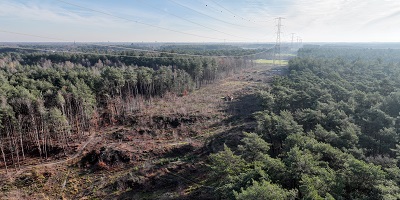Nature conservation work under the Massenhoven-Meerhout-Van Eyck line
Since late last year, Elia has been busy with nature conservation work under the line running between the Massenhoven, Meerhout and Van Eyck high-voltage substations in Kinrooi. We are improving the ecological values of the ecosystems that our high-voltage line passes through by pruning, removing exotic species and logging. The aim is to expand natural areas and promote more diverse fauna and flora.
High-voltage line upgrade
Elia's Massenhoven-Van Eyck project aims to upgrade an important connection in Belgium's 380-kV grid. This voltage level forms the backbone of our grid and can quickly and efficiently transmit large quantities of electricity. It is necessary in connection with the energy transition, since, in the future, both industry and consumers will consume much more electricity than they do today. In addition, renewable energy sources are being connected to the electricity grid all over the country, causing an increase in domestic electricity flows throughout Belgium. This project is needed in order to be able to more efficiently distribute and transmit electric current via the 380-kV grid and facilitate the import and export of electricity between Belgium and the Netherlands, which is vital for Belgium's security of supply.
Nature management plan
As part of this major project, which spans no fewer than fifteen municipalities, a nature management plan was drawn up by Arcadis, a consultancy, in collaboration with Agentschap Natuur en Bos (Flemish conservation agency). The purpose of this document is to regulate the management and protection of natural areas. The aim is to protect and expand ecosystems while improving biodiversity. In the context of this project, this means that we have mapped out those areas (e.g. Zwarte Beek, Bolisserbeek, Ham-Balen area along the canal, etc.) we cross and the specific characteristics those areas have in terms of ecological values with regard to fauna and flora. In addition, efforts were made to study the quality goals these different areas must achieve and which surface area would be ideal for achieving fully fledged nature conservation. Our goal is to restore ecological values via maintenance, in terms of both habitat and species. Not every area is the same: a swamp, for example, will require a different approach than heathland.
Hechtel-Eksel heath
Last Friday, 2 February, we went with the press to take a look at Hechtel-Eksel, where we intend to restore the Limburg heath where it has been overgrown by fir trees planted for mining and other low-value nature. Elia will maintain the sites at its own expense for 24 years to expose the sandy soil and rid it of American bird cherry and other exotic species. After all, the heath is actually a 'seed bank': the seeds from that time are still in the ground and the heath vegetation can return once it gets a chance to do so. That is what we aim to do. In other places, the nature management plan imposes other measures, such as planting, mowing, removing stumps and so on.


